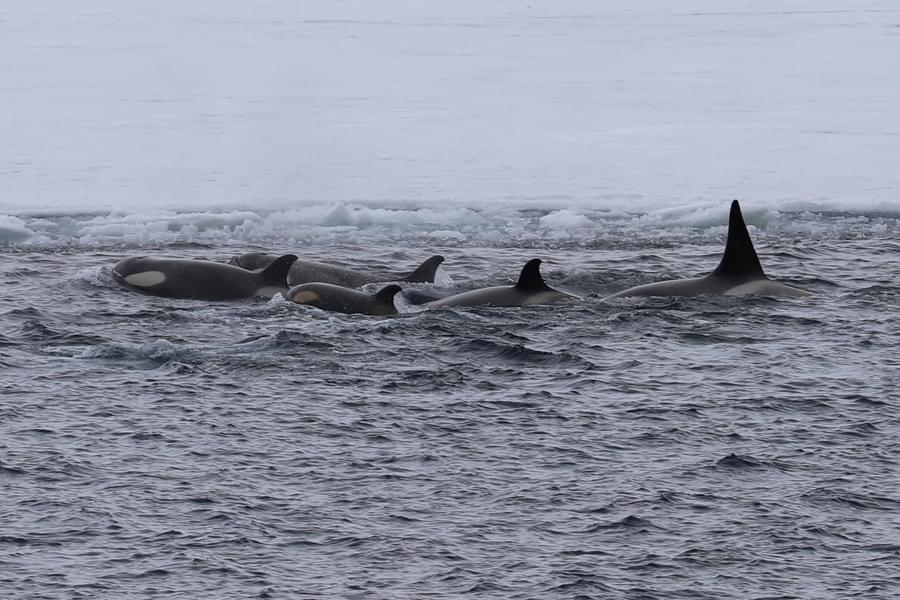With the Antarctic season well and truly underway, recent Ocean Conservationist Graduate Gemma has taken a deeper look into the killer whales that call this icy world home…
Second only to humans, killer whales (Orcinus orca) are one of the most widely distributed mammals on the planet. Highly intelligent and social animals with complex social structures, despite their name, killer whales are in fact the largest member of the dolphin family. They are the largest apex predator in the ocean, meaning they have a crucial role in keeping marine ecosystems healthy.
Although currently recognised as one single species, there have been ~10 different killer whale ecotypes described so far, with some so different from each other that scientists suggest they should even be considered different species. An ecotype can be roughly defined as ‘variants of a species adapted to distinct environments’ (1,2) . In the Southern Ocean alone, there are five different killer whale ecotypes which differ in terms of their physical appearance, genetics, habitat preferences, social structures, prey specialisation, and vocal repertoires. These ecotypes are known as: Antarctic Type A, Type B (there are two forms: Pack ice Type B large form, and Gerlache Type B small form), Ross Sea Type C and Sub-Antarctic Type D (3).
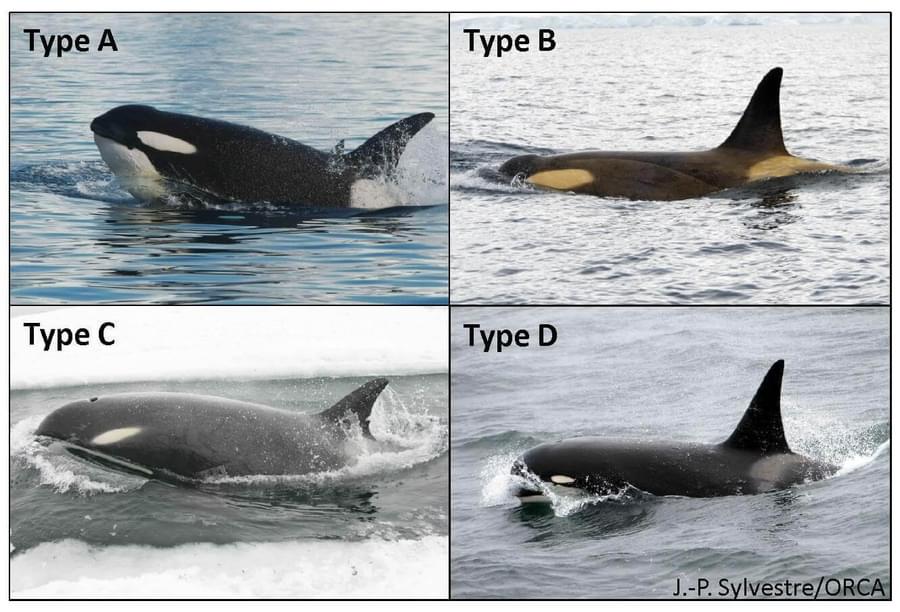
Let’s dive in and take a look at some of the specialised adaptations that these ecotypes have, how they can be recognised, and how they are different from each other.
Antarctic Type A killer whale
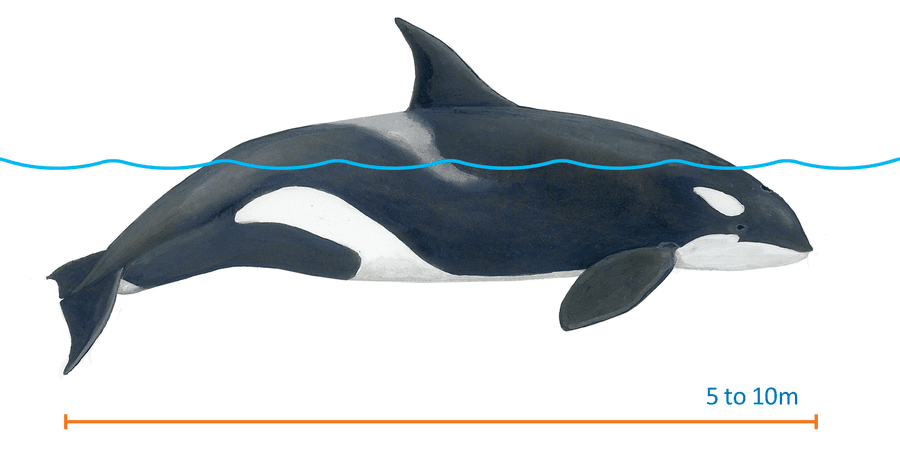
Type A killer whales have a ‘typical’ physical appearance and look very similar to killer whales observed in other parts of the world with their iconic black and white markings and eye patch parallel to their body axis. This ecotype is mammal-eating and has a preference for other cetaceans, particularly Antarctic minke whales (Balaenoptera bonaerensis) and they hunt in open areas of the Southern Ocean that are ice-free (4,5). As with other killer whales, the large dorsal fin in adult males (which can be six feet tall!) makes them distinguishable from adult females. The saddle patches are unique to each individual (much like human fingerprints). As these killer whales prefer the open ocean, they are hard to track down and study and there still remains a lot to learn about them.
Type B killer whales (Pack ice large form)
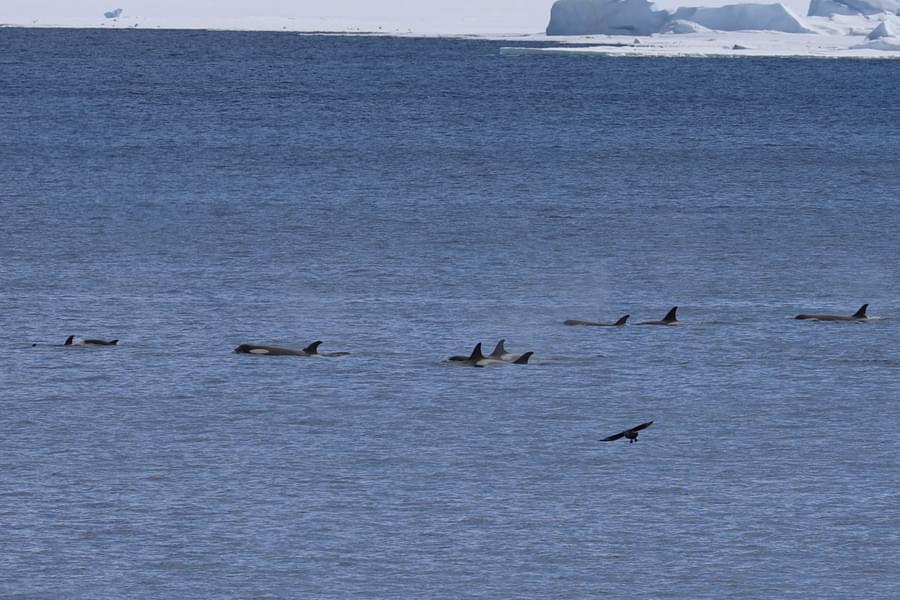
It was once thought that Type B killer whales were one ecotype, but they have been separated into two ecotypes. The pack ice large form were named as they hunt seals amongst the pack ice using their remarkable technique of wave-washing (5). This highly coordinated technique involves the killer whales spy hopping (raising their head out of the water to look above the surface) to search for a seal on the ice floes. Once located, the killer whales swim in synchrony towards the ice floe, creating powerful waves that break up the ice where seals are resting . Once the ice floe has been split, the seal is washed into the water where the killer whales can catch it. Seals that have been preyed on using this technique include Weddell seals (Leptonychotes weddellii), southern elephant seals (Mirounga leonina), crabeater seals (Lododon carcinophaga) and even the second largest predator in Antarctica - the mighty leopard seal (Hydrurga leptonyx).
Wave-washing requires incredible skill and precision and takes years of practice for these killer whales to perfect. Specialised hunting techniques like this are learnt culturally and passed down between generations. These killer whales look different to other ecotypes as they can have a yellow or brown tint due to diatoms (a type of algae) on their skin. Their dark dorsal cape is also very distinctive compared to other ecotypes (6). This ecotype has the largest eye patch compared to the other killer whale ecotypes as you can see from the image.
Type B killer whales (Gerlache small form)
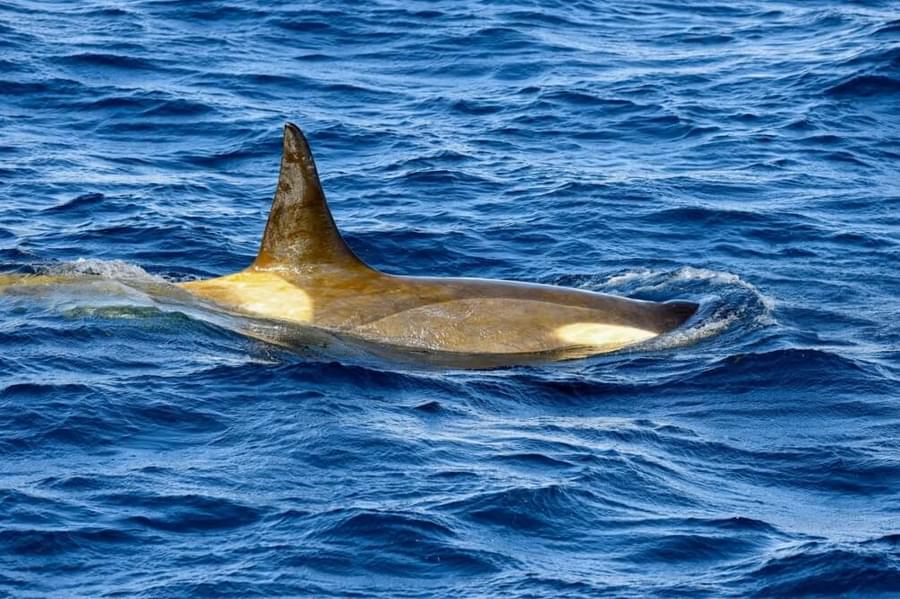
Named after the Gerlache Strait of the Antarctic Peninsula where they are often seen (5), these smaller Type B killer whales are roughly half the size of the larger pack ice form. These killer whales do however share similarities such as the noticeably larger eye patch and unique dorsal cape colouration with the larger Type B form (6). This ecotype is also affected by diatoms, with a resultant yellow or brown tint to their skin. Their dietary preferences and hunting techniques remain largely unknown although it has been reported that they hunt penguins (5,6). Research suggests that these killer whales dive to great depths (around 500-700m), which could indicate they are diving to prey on fish or squid (5,6). There is still a lot that is unknown about this smaller Type B form as they also prefer the open ocean, so continued research is very important to find out more about them.
Excitingly, the ORCA Marine Mammal Surveyor Team and guests on board Hurtigruten MS Fram recorded a pod of 18 Type B small form orcas in November 2023 - see image above.
Ross Sea Type C killer whales
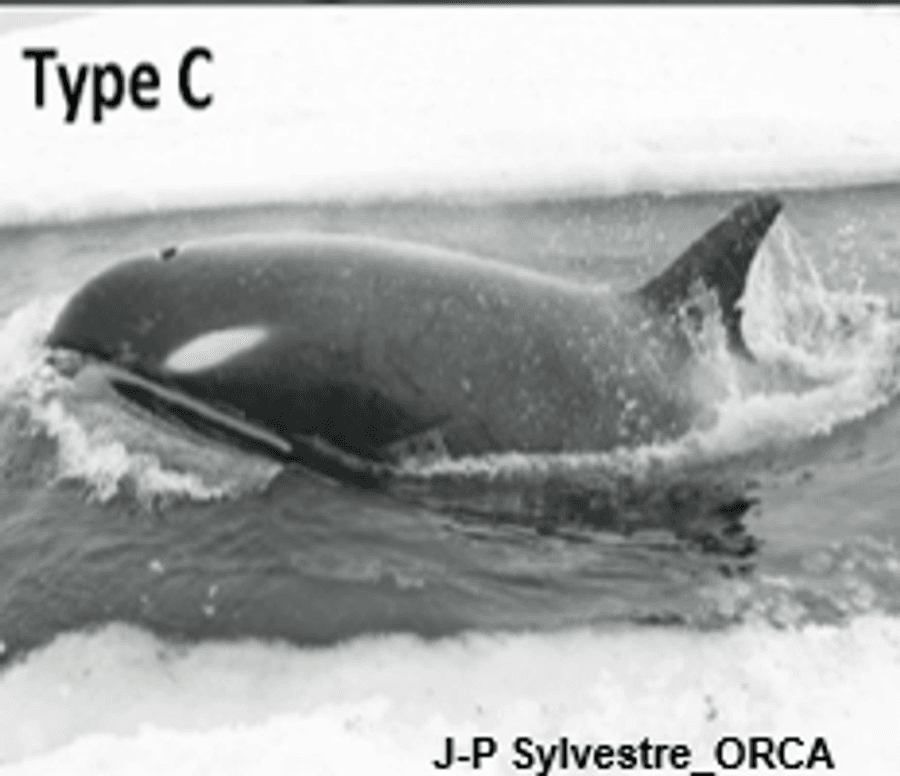
Ross Sea Type C killer whales have been frequently seen in McMurdo Sound, Ross Sea, eastern Antarctica for over a hundred years (3). This ecotype has been observed during summer sightings off eastern Antarctica, and they are found in continental shelf waters (3). Type C orca can also be found in areas of dense ice where they specialise in hunting Antarctic toothfish (Dissostichus mawsoni) and other fish species (3). These are the smallest form of killer whale known, with adult males reaching around 6.1m compared to adult Type A males which can grow up to 9.2m. Their eye patch is smaller and narrower than other ecotypes and has a unique slanted appearance. This ecotype can also look yellow or brown due to diatoms but can be reliably distinguished from other ecotypes using features such as the smaller body size and slanted eye patch (3). The vocal behaviour of this ecotype has been shown to consist of a high number of different call types and they are vocal whilst hunting, which is unusual (3). Mammal-eating ecotypes are often silent whilst hunting as their prey could detect the killer whales if they are too noisy when they approach. As Ross Sea Type C’s feed on fish, it is possible that this affects the vocal behaviour of these killer whales as fish have limited hearing capabilities and may be less likely to hear the killer whales approaching.
Sub-Antarctic Type D killer whales
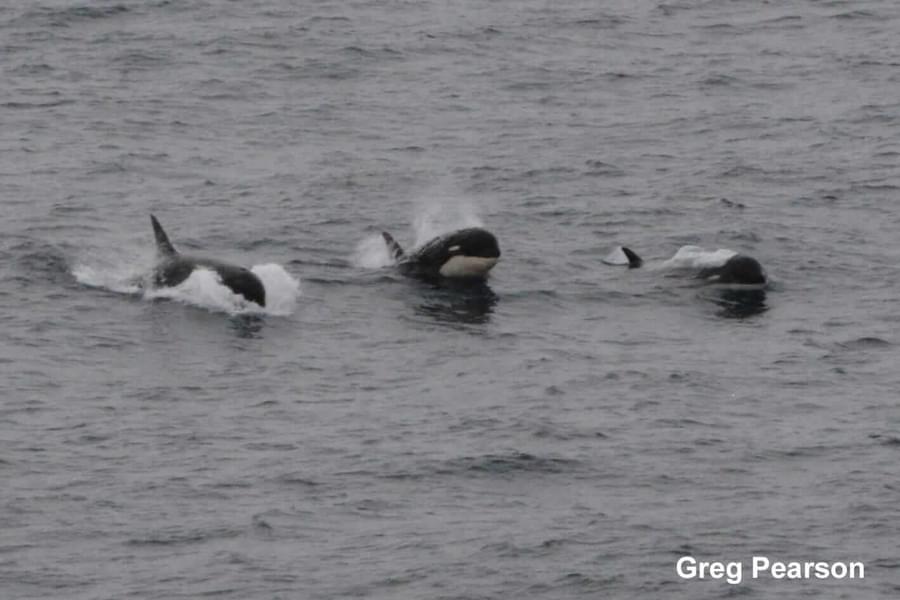
There are dramatic differences in the physical appearance of the Sub-Antarctic Type D killer whales compared to the other ecotypes (7). The eye patch is tiny and is the smallest of any killer whale ecotype. The forehead is very bulbous, and in some cases their head shape almost resembles that of a pilot whale (Globicephala spp) (8). Another visible difference is the shape of the male’s dorsal fin. Other ecotypes have a straight, pointed shape whereas this ecotype has a swept back appearance. There have been no reports of Type D killer whales having the yellow/brown tint seen in some of the other Antarctic ecotypes (7). It is thought that Type D killer whales feed on fish such as Patagonian toothfish (Dissostichus eleginoides) as they have been seen interacting with toothfish long-liners, but not much else is known about their diet (8,9). Once again, this ecotype has a preference for offshore waters of the Southern Ocean, and studying them is very challenging. There have only been a handful of sightings, however guests on Albatros’ Ocean Victory were lucky enough to sight them in November 2023 (see image taken by Greg Pearson). It was a mass stranding event in New Zealand enabled researchers to identify these killer whales as a distinct ecotype. A recent genetic study found that Type D killer whales are one of the most inbred mammals ever recorded, and it appears that they do not breed with other killer whale ecotypes which could provide evidence for classifying them as a different species sometime in the future. (8) However, in common with most killer whales, Type D’s are so rarely sighted, much of their behaviour remains a total mystery!
ORCA’s impact
All of these different killer whale ecotypes are examples of Antarctica’s magnificent, incredibly diverse wildlife. Protecting Antarctica and the species that live there is essential for so many reasons. It plays a critical role in regulating global climate patterns and sea levels, and protecting this region is not only vital for maintaining biodiversity, but also for safeguarding our planet’s environmental balance. International cooperation and continued research efforts are vital for the long-term conservation of this unique and sensitive ecosystem. This is why ORCA’s work is so important, as we contribute towards vital data collection efforts in collaboration with our industry partners and scientists at the British Antarctic Survey. With our data collection, we can help to better understand the behaviour and ecology of iconic species such as killer whales and help to identify ways in which we can protect them, their habitats and safeguard their future.
There are lots of ways that you can support our work in Antarctic waters and elsewhere! Why don’t you join us and help to collect data by training as a Marine Mammal Surveyor? Or you could subscribe to one of our monthly memberships where you can hear exciting updates about our latest work! You can also become an Antarctic Ambassador by downloading the Ambassadorship Challenge here to see how you can help - see if your friends and family are up for taking the challenge with you! Together, we can protect the animals we love like the beautiful and varied killer whale ecotypes and preserve them for future generations.
References
Turesson, G., 1922. The species and the variety as ecological units. Hereditas, 3(1), pp.100-113.
Stronen, A.V., Norman, A.J., Vander Wal, E. and Paquet, P.C., 2022. The relevance of genetic structure in ecotype designation and conservation management. Evolutionary applications, 15(2), pp.185-202.
Wellard, R., Pitman, R.L., Durban, J. and Erbe, C., 2020. Cold call: the acoustic repertoire of Ross Sea killer whales (Orcinus orca, Type C) in McMurdo Sound, Antarctica. Royal Society Open Science, 7(2), p.191228.
Filatova, O.A., Borisova, E.A., Shpak, O.V., Meschersky, I.G., Tiunov, A.V., Goncharov, A.A., Fedutin, I.D. and Burdin, A.M., 2015. Reproductively isolated ecotypes of killer whales Orcinus orca in the seas of the Russian Far East. Biology Bulletin, 42, pp.674-681.
Fearnbach, H., Durban, J.W., Ellifrit, D.K., Paredes, A., Hickmott, L.S. and Pitman, R.L., 2022. A decade of photo‐identification reveals contrasting abundance and trends of Type B killer whales in the coastal waters of the Antarctic Peninsula. Marine Mammal Science, 38(1), pp.58-72.
Durban, J.W., Fearnbach, H., Burrows, D.G., Ylitalo, G.M. and Pitman, R.L., 2017. Morphological and ecological evidence for two sympatric forms of Type B killer whale around the Antarctic Peninsula. Polar Biology, 40, pp.231-236.
Pitman, R.L., Durban, J.W., Greenfelder, M., Guinet, C., Jorgensen, M., Olson, P.A., Plana, J., Tixier, P. and Towers, J.R., 2011. Observations of a distinctive morphotype of killer whale (Orcinus orca), type D, from subantarctic waters. Polar Biology, 34, pp.303-306.
Foote, A.D., Alexander, A., Ballance, L.T., Constantine, R., Galletti Vernazzani Muñoz, B., Guinet, C., Robertson, K.M., Sinding, M.H.S., Sironi, M., Tixier, P. and Totterdell, J., 2023. “Type D” killer whale genomes reveal long-term small population size and low genetic diversity. Journal of Heredity, 114(2), pp.94-109.
Tixier, P., Gasco, N., Duhamel, G. and Guinet, C., 2016. Depredation of Patagonian toothfish (Dissostichus eleginoides) by two sympatrically occurring killer whale (Orcinus orca) ecotypes: insights on the behavior of the rarely observed type D killer whales. Marine mammal science, 32(3), pp.983-1003.

